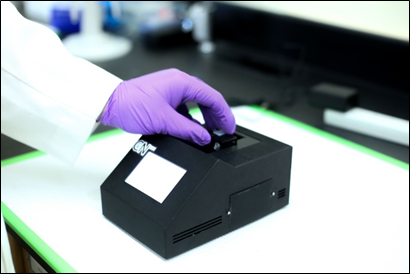The overarching themes of my research are bioanalytical chemistry, sample preparation and materials/organic chemistry. The bioanalytical research focuses on the detection of chemical and biological warfare (CBW) agents or toxic environmental contaminants via their chemical or biological signatures. The materials/organic chemistry portion of the LARGE group focuses on the development of functionalized carboxylate deposition (FCD; an novel surface bonding chemistry developed in the LARGE group) as it pertains to chromatography and dye-sensitized solar cells. The sample preparation portion of the group is developing ICECLES (ICE Concentration Linked with Extractive Stirrer). Current and future projects include research in CBW agent detection, environmental contaminant analysis, sensor development and the analysis of flavor compounds via ICECLES.
Determining past exposure to CBW agents in biological matrices is difficult because the "window of detection" of most chemical agents is very short. In the human body, the upper residence time for most metabolites of most chemical agents is approximately five days. To address this problem, research in the discovery of metabolites (i.e., products of the conversion of chemicals through normal biological processes in an organism) with longer residence times can be pursued and analytical methods developed to analyze those metabolites. One current project focuses on analysis of a promising, little-studied cyanide metabolite in blood and urine for verification of past exposure to cyanide. Alternatively to finding novel metabolites, a matrix that stores and protects currently known metabolites would allow a longer window of detection. Hair has shown great promise in its ability to address this problem as metabolites get trapped in the hair matrix and are protected from degradation. Therefore, we may be able to greatly extend the window of detection of CBW agent exposure. Another project in the area is the development of a fluorometric sensor for the diagnosis of cyanide exposure.

The ability to analyze contaminants at “ultratrace” concentrations (defined as ng/L to pg/L, commonly referred to as parts-per-trillion (ppt) and parts-per-quadrillion (ppq), respectively) is a critically important, but currently challenging, aspect of ensuring safe drinking water. The Environmental Protection Agency (EPA) Maximum Contaminant Level Goal (MCLG) is zero for several compounds; however, the enforceable contaminant level, called the Maximum Contaminant Level (MCL), is set, in part, according to "…the ability of laboratories to measure accurately and consistently the level of the contaminant with available analytical methods." This typically limits MCLs to the parts-per-billion (ppb) (μg/L) range. Our recently discovered technique, coined ICECLES has the potential to more easily allow ultratrace analysis of compounds important to drinking water safety. ICECLES combines the highly complementary techniques of stir bar sorptive extraction (SBSE) with freeze concentration (FC). In FC, solutes are concentrated based on the direct relationship between freezing point depression and solute molality. If a solution is slowly frozen (typically with vigorous stirring), then local regions of solvent with a low solute concentration are frozen first: the solution left behind is more concentrated. Combining FC and SBSE into ICECLES has produced compelling preliminary findings, including pg/mL limits of detection and >1000-fold signal increases compared to SBSE. ICECLES is likely to enable ultratrace analysis of analytes that currently cannot easily be analyzed at the desired concentrations (e.g., maximum contaminant levels). REU students involved in the project will develop methods of analysis to determine ultratrace concentrations of toxic compounds from drinking water using the ICECLES sample preparation technique. During the REU project, students will gain knowledge in this innovative technique, but will also gain experience with fundamental analytical principles, SBSE and gas-chromatography mass-spectrometry.
Research on solar energy is extremely timely and important to our future. If properly harnessed, solar energy could provide enough power for world consumption many times over. The problem lies in converting this energy cheaply into a usable form. Currently, solid state crystalline silicon solar cells are used in most applications. They are very expensive to produce and do not harness the entire spectrum of solar energy. A type of solar cell called a dye-sensitized solar cell (DSSC) has been developed that does not use the high purity silicon of traditional solar cells. Therefore, these cells have the possibility of low cost production. Our group is interested in developing novel dye molecules and cell designs to increase the efficiency and robustness of DSSCs. Success could greatly increase efficiencies of these cells which would reduce the cost of the energy produced.
In light of recent events, our research in the field of chemical and toxic agent detection, as well as research in surface modification and ICECLES development, is very timely and exciting. Our research is directly applicable to the welfare of human beings and the environment that we live in, making this work very relevant our own lives in the 21st century. For more information follow the links to my research pages on the right of this page in the "Research Links" box or the link to the research group Facebook page in the "Additional Links" box. Information on equipment, research, funding, etc. is listed under the "Research Links" box and photographs of some of the group activities are on the Facebook page.

